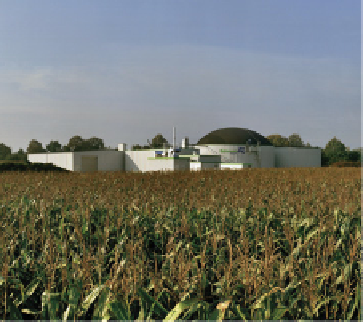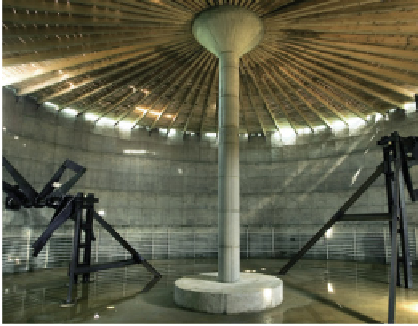Environmental Engineering Reference
In-Depth Information
process mainly converts the biomass into water, carbon dioxide and methane. The
biogas plant captures the gaseous components. The biogas extracted in this way
consists of 50 to 75% combustible methane and 25 to 45% carbon dioxide. Other
components include steam, oxygen, nitrogen, ammonia, hydrogen and sulphur
hydrogen.
Figure 12.16
Biogas plant in a cornfi eld and view of interior with stirrer.
Source: Schmack Biogas AG.
At further stages the biogas is purifi ed and desulphurized. It is then stored in a gas
storage tank. The biogas yield varies considerably depending on the type of biomass
substrate. Whereas with cow dung the gas yield is around 45 cubic metres per ton,
with corn silage the yield is at least 200 cubic metres per ton.
Biogas is used mostly in internal combustion engines. Petrol engines and modifi ed
diesel engines are both appropriate. If the engine drives an electric generator, it
can produce electric power from biogas. The waste heat from the engine is also
useable.
After further processing, biogas can be fed directly into the natural gas grid. This
requires the removal of any trace gases, water and carbon dioxide. Green gas
suppliers are now marketing feed-in biogas in some parts of Germany. Changing
over to this type of gas supplier will actively promote the expansion of biogas
production.
12.5 Planning and Design
The possibilities for using biomass are extremely diverse, and would merit an entire
topic all to themselves. Therefore, this section confi nes itself to the planning and
design of fi rewood boilers and pellet heating systems. Both systems are especially
relevant to single-family homes.


